
In Christian art, a Madonna is a religious depiction of the Blessed Virgin Mary in a singular form or sometimes accompanied by the Child Jesus. These images are central icons for both the Roman Catholic and Orthodox churches. The word is from Italian ma donna 'my lady' (archaic). The Madonna and Child type is very prevalent in Christian iconography, divided into many traditional subtypes especially in Eastern Orthodox iconography, often known after the location of a notable icon of the type, such as the Theotokos of Vladimir, Agiosoritissa, Blachernitissa, etc., or descriptive of the depicted posture, as in Hodegetria, Eleusa, etc.

Madonna Della Strada or Santa Maria Della Strada is a painting of Mary, mother of Jesus at the Church of the Gesù in Rome, mother church of the Society of Jesus (Jesuits) religious order of the Catholic Church; it is a variation on the basilissa (imperial) type of icon.
A miniature shrine, also referred to in literature as a portable shrine,pocket shrine, or a travel altar, is a small, generally moveable shrine or altar. They vary greatly in size and architectural style, and by which region or culture produced them.

A novena is an ancient tradition of devotional praying in Christianity, consisting of private or public prayers repeated for nine successive days or weeks. The nine days between the Feast of the Ascension and Pentecost, when the disciples gathered in the upper room and devoted themselves to prayer, is often considered to be the first novena.

A bathtub Madonna is an artificial grotto typically framing Our Lady of Lourdes, commonly found in Catholic regions of the U.S.

A retablo is a devotional painting, especially a small popular or folk art one using iconography derived from traditional Catholic church art. More generally retablo is also the Spanish term for a retable or reredos above an altar, whether a large altarpiece painting or an elaborate wooden structure with sculptures. Typically this includes painting, sculpture, or a combination of the two, and an elaborate framework enclosing it. The Latin etymology of the Spanish word means "board behind". Aside from being found behind the altar, "similar ornamental structures are built and carved over facades and doorways", called overdoors.

A santo ('saint') is a religious statue in the Catholic traditions of Spain and the former Spanish Empire. They are usually made of wood or sometimes ivory and may be fitted with textile clothing. They depict the Virgin Mary, Jesus, saints, or angels. A santero is a craftsperson who makes the image. Some santos which have gained greater public devotion among the faithful have also merited papal approval through canonical coronations. Santos remain a living tradition of religious iconography and folk art in Mexico, the Philippines, Puerto Rico and some other Caribbean islands, South and Central America, and the Southwestern United States, especially New Mexico.

Milagros are religious folk charms that are traditionally used for healing purposes and as votive offerings in Mexico, the southern United States, other areas of Latin America, and parts of the Iberian Peninsula. They are frequently attached to altars, shrines, and sacred objects found in places of worship, and they are often purchased in churches and cathedrals, or from street vendors.

Retablos are a sophisticated Peruvian folk art in the form of portable boxes which depict religious, historical, or everyday events that are important to the Indigenous people of the highlands. It is a tradition originated in Ayacucho.
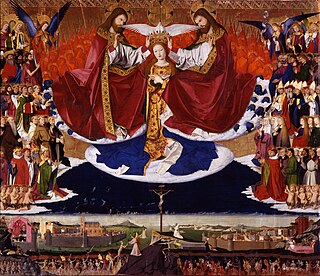
Catholic art is art produced by or for members of the Catholic Church. This includes visual art (iconography), sculpture, decorative arts, applied arts, and architecture. In a broader sense, Catholic music and other art may be included as well. Expressions of art may or may not attempt to illustrate, supplement and portray in tangible form Catholic teaching. Catholic art has played a leading role in the history and development of Western art since at least the 4th century. The principal subject matter of Catholic art has been the life and times of Jesus Christ, along with people associated with him, including his disciples, the saints, and motifs from the Catholic Bible.
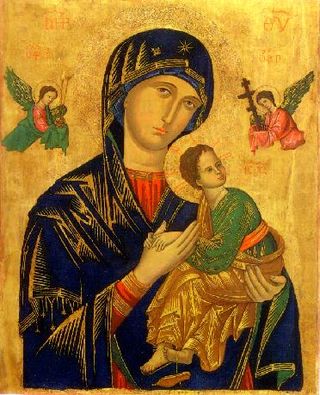
Mary has been one of the major subjects of Western art for centuries. There is an enormous quantity of Marian art in the Catholic Church, covering both devotional subjects such as the Virgin and Child and a range of narrative subjects from the Life of the Virgin, often arranged in cycles. Most medieval painters, and from the Reformation to about 1800 most from Catholic countries, have produced works, including old masters such as Michelangelo and Botticelli.
Amalia Mesa-Bains, is a Chicana curator, author, visual artist, and educator. She is best known for her large-scale installations that reference home altars and ofrendas. Her work engages in a conceptual exploration of Mexican American women's spiritual practices that addresses colonial and imperial histories of display, the recovery of cultural memory, and their roles in identity formation.
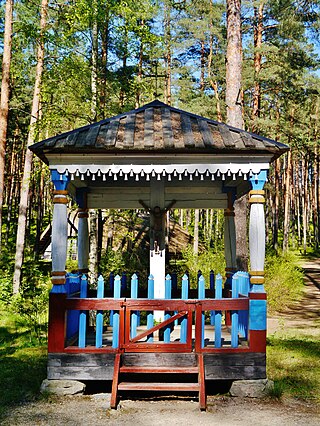
A wayside shrine is a religious image, usually in some sort of small shelter, placed by a road or pathway, sometimes in a settlement or at a crossroads, but often in the middle of an empty stretch of country road, or at the top of a hill or mountain. They have been a feature of many cultures, including Chinese folk religious communities, Catholic and Orthodox Europe and some Asian regions.
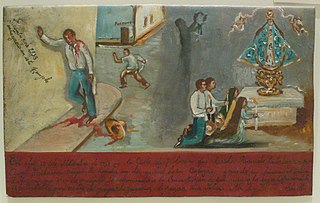
Votive paintings in Mexico go by several names in Spanish such as “ex voto,” “retablo” or “lámina,” which refer to their purpose, place often found, or material from which they are traditionally made respectively. The painting of religious images to give thanks for a miracle or favour received in this country is part of a long tradition of such in the world. The offering of such items has more immediate precedence in both the Mesoamerican and European lines of Mexican culture, but the form that most votive paintings take from the colonial period to the present was brought to Mexico by the Spanish. As in Europe, votive paintings began as static images of saints or other religious figures which were then donated to a church. Later, narrative images, telling the personal story of a miracle or favor received appeared. These paintings were first produced by the wealthy and often on canvas; however, as sheets of tin became affordable, lower classes began to have these painted on this medium. The narrative version on metal sheets is now the traditional and representative form of votive paintings, although modern works can be executed on paper or any other medium.

Cartonería or papier-mâché sculptures are a traditional handcraft in Mexico. The papier-mâché works are also called "carton piedra" for the rigidness of the final product. These sculptures today are generally made for certain yearly celebrations, especially for the Burning of Judas during Holy Week and various decorative items for Day of the Dead. However, they also include piñatas, mojigangas, masks, dolls and more made for various other occasions. There is also a significant market for collectors as well. Papier-mâché was introduced into Mexico during the colonial period, originally to make items for church. Since then, the craft has developed, especially in central Mexico. In the 20th century, the creation of works by Mexico City artisans Pedro Linares and Carmen Caballo Sevilla were recognized as works of art with patrons such as Diego Rivera. The craft has become less popular with more recent generations, but various government and cultural institutions work to preserve it.

Sawdust carpets are one or more layers of colored sawdust, and sometimes other additional materials, laid on the ground as decoration. Sawdust carpets are traditionally created to greet a religious procession that walks over them. The tradition of decorating streets in this fashion began in Europe and was brought to the Americas by the Spanish. The tradition is still found in Mexico, Central America, parts of South America and parts of the United States, but it is strongest in Mexico and Central America.
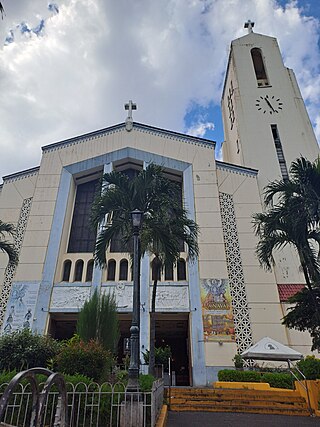
Santo Domingo Church, formally known as the National Shrine of Our Lady of the Holy Rosary of La Naval de Manila, is a Roman Catholic parish church and national shrine in Quezon City, Metro Manila in the Philippines. It is under the jurisdiction of the Diocese of Cubao. Dedicated to Mary, mother of Jesus under her title Our Lady of the Most Holy Rosary — La Naval de Manila, it was founded by the Dominicans in 1587.

San Pedro Apostol Parish Church, commonly known as Loboc Church and alternatively as the Diocesan Shrine of Our Lady of Guadalupe in Extremadura, is a Roman Catholic church in the municipality of Loboc, Bohol, Philippines, within the jurisdiction of the Diocese of Tagbilaran.
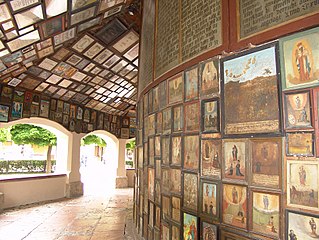
A votive offering or votive deposit is one or more objects displayed or deposited, without the intention of recovery or use, in a sacred place for religious purposes. Such items are a feature of modern and ancient societies and are generally made to gain favor with supernatural forces.
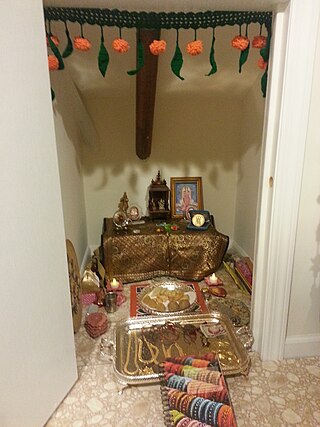
The Conservation of South Asian household shrines is an activity dedicated to the preservation of household shrines from South Asia. When applied to cultural heritage, held by either museums or private collectors, this activity is generally undertaken by a conservator-restorer. South Asian shrines held in museum collections around the world are principally shrines relate to Hindu, Jain, or Buddhist households. Due to their original use and sacred nature, these shrines present unique conservation and restoration challenges for those tasked with their care.

















